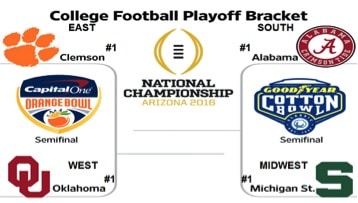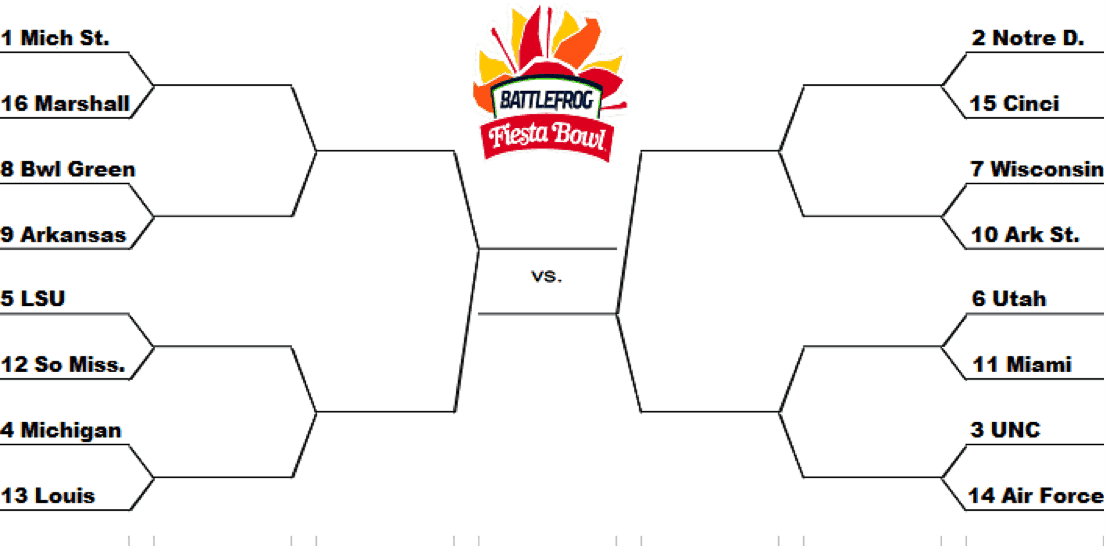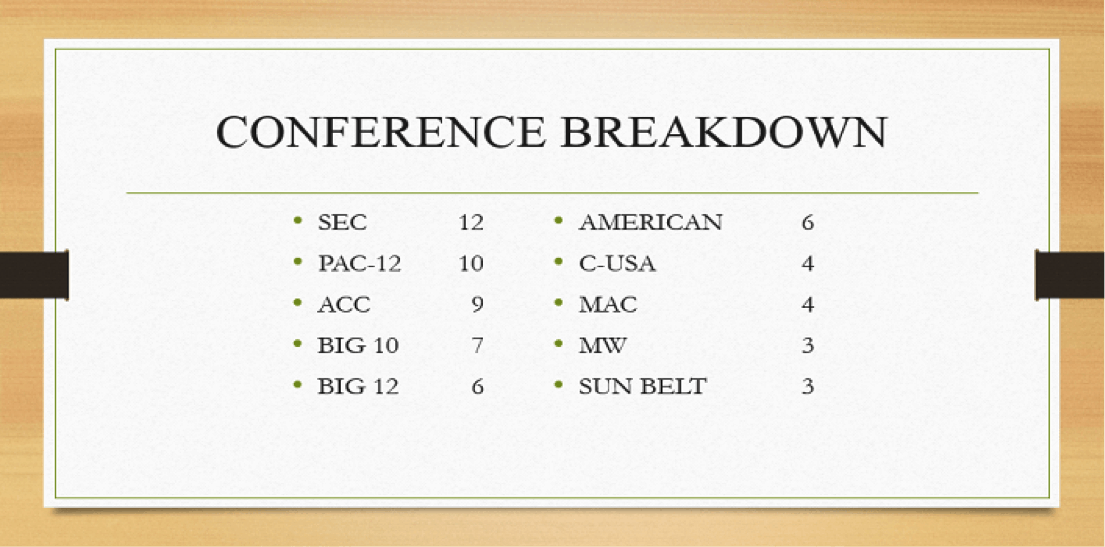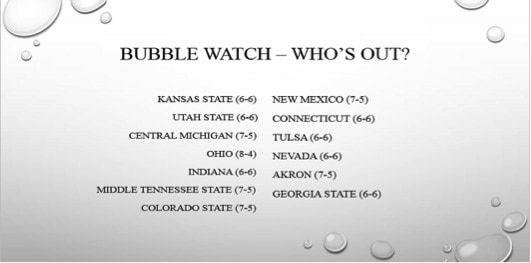By Kevin Green
It is survival of the fittest. Win or go home. David versus Goliath.
That is the law of March Madness, and whether it is the buzzer beaters, the Cinderella teams or simply filling out bracket after bracket, the magic the NCAA Tournament produces seems to draw people in every year.
No matter which teams are playing, millions of people around the country are glued to their televisions to see if their unique brackets will bring them one step closer to perfection, or if they will be rendered useless following the first wave of upsets.
Although I genuinely enjoy all of the madness, I’m usually still in football mode. Specifically college football mode. I dream about what it would be like to see an NCAA Tournament-esque college football playoff. Four teams is not enough for me. I know it is unrealistic, but I want to see 64 college football teams battle it out over six or seven weekends in December and January to determine the ultimate national champion.
I suppose you don’t always get what you want, but I decided to take it upon myself to make this particular dream become a reality.
I took the role of the selection committee to see how the college football season would have played out in a 64-team playoff. I selected the teams and divided them into four geographical regions (East, South, Midwest and West) consisting of 16 teams each. This is a hypothetical postseason, so the seeds are based on the end of the regular season. To complete the seeding, I used the final CFB Playoff rankings to seed the Top 25 teams, and for the remaining 39 teams, I took the average ranking of each team using three polls that rank all 128 teams in FBS Division I (USA Today, CBS Sports and Bleacher Report).
Of course, I’m not satisfied with only making the bracket. I want to see how this fantasy would play out, so every game will be simulated 25 times using the WhatIfSports game simulator, a complex algorithm that simulates any matchup of teams, in order to ensure the most accurate results possible. The round-by-round results will be posted at a later date.
How different would the college football landscape look with a 64-team playoff? Would Alabama still have won its third championship in five years? Would Clemson have become the greatest team of all time with 19 wins? Would teams like Iowa, Stanford, Ohio State and Notre Dame make up for their late-season losses? Would a non-Power Five team like Houston prove itself?
Let the games begin. Here are the four No. 1 seeds.
Similar to the NCAA Tournament, the No. 1 seeds have been set up for a Final Four where the overall No. 1 seed would play the fourth No. 1, while the second and third No. 1 seeds would play each other. In this case, the winner of the East Region would play the winner of the West Region in one semifinal game, and the other semifinal would pit the winner of the South Region against the winner of the Midwest Region.
Related: POLL – Which of the top seeds would have the easiest route to the final four?
TOURNAMENT LOCATIONS
The first-round games will be played on the campuses of the top-seeded teams. To ensure the bowl games we all know and love aren’t eliminated, starting in the second round the games will be played in bowls. Each region has assigned bowls for each round based on geographical location. The highest-seeded teams will be placed in bowl games closest to their geographical locations. If the closest bowl to a team’s geographical location is already taken, it will be placed in the next closest bowl. The Elite Eight locations can be seen in each region’s bracket. The Orange Bowl and Cotton Bowl will remain the Final Four locations, and the University of Glendale Stadium in Arizona will still host the national championship.
Now, let’s take a look at the bracket. Who’s in?
EAST REGION
It is easy to pick Clemson as the favorite of this region, but Ohio State is certainly more than a threat to the Tigers. The Buckeyes lost late in the season to Michigan State at home, but after their domination of rival Michigan to close the regular season, it looks like that loss could have been the wake-up call the defending champions needed to make a championship run. Clemson takes on Auburn in a preview of the teams’ season-opening game next season, and Ohio State faces an inferior Georgia Southern team from the Sun Belt.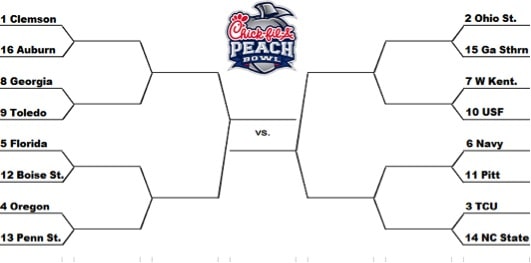
In terms of potential first-round upsets, the matchup between No. 5 Florida and No. 12 Boise State stands out from the rest. The Gators struggled mightily on offense in the second half of the season after losing starting quarterback Will Grier. The Broncos lost two of their last three games, with their offensive production tapering off as well. Whichever defense wins the war in the trenches will help its team advance.
The most underrated game of the region is No. 8 Georgia vs. No. 9 Toledo. It will be a battle of head coach-less teams and contrasting styles of play. Elsewhere, the 7 vs. 10 and 6 vs. 11 games are matchups that actually took place during the bowl season. Will they have different outcomes from their real-life counterparts?
TCU has a chance to sneak its way to the Elite Eight and possibly even the Final Four. The Horned Frogs were a tipped two-point conversion away from being a one-loss team and possibly a No. 2 seed in this tournament. TCU has a strong offensive attack, but its hot-and-cold defense prevented the team from getting the same respect it did last season. However, with Trevone Boykin healthy, it seems the pieces might be finally starting to come together for the Horned Frogs. A possible matchup in the Sweet 16 with No. 2 Ohio State, the team that cost TCU a spot in the College Football Playoff last season, will give us a good idea if this team is a contender or a pretender.
WEST REGION
Despite a head-scratching loss to Texas in October, Oklahoma locked up a No. 1 seed by bullying its way through the rest of the Big 12, winning its last seven games by an average of more than 32 points per game. The Sooners face a dangerous Arizona team in the first round and could see a couple of offensive juggernauts in the upcoming rounds should they advance that far.
If it is brand power you are looking for, a meeting between OU and UCLA in the second round would certainly provide that. However, San Diego State is more than capable of hanging with the Bruins. A possible rematch with Baylor could be in line for the Sooners as well, and a meeting with Stanford in the Elite Eight would be a marquee matchup and ratings drawer, fitting for the Rose Bowl.
Before injury-ridden Baylor can even think about a rematch with OU, it will have to get past Cal in what would be the “Battle of the Bears.” This one is sure to produce a lot of points, but with so many impact players missing (Seth Russell, Jarrett Stidham, Shock Linwood and Corey Coleman), Baylor’s offense might not be able to keep up with Jared Goff and Cal’s offense. Don’t be surprised if Baylor makes an early exit from the tournament.
In a battle of contrasting styles, No. 4 Northwestern vs. No. 13 Washington will feature a Pac-12 offense against a Big 10 defense. If the Huskies get the upset and Cal puts Baylor out of its misery, a double-digit seed will be guaranteed a spot in the Sweet 16. We’re only halfway through the bracket, and we’ve already come across two potential Cinderella teams. See, isn’t this fun?
Elsewhere in the region, No. 7 USC meets No. 10 BYU in a setup for Stanford-USC III. No. 6 Temple vs. No. 11 West Virginia also looks to be a fascinating matchup.
SOUTH REGION
Alabama has yet another shot at a national championship, this time as the No. 1 seed of the South Region. Nick Saban’s squad takes on Virginia Tech in what will be Frank Beamer’s last game. The Crimson Tide will not show mercy, winning handily before getting the winner of No. 8 Mississippi State and No. 9 Washington State in what has the potential to be one of the most exciting games of the first round.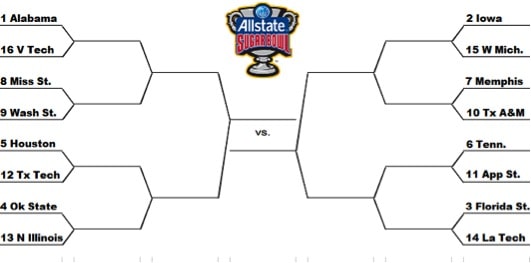
As for potential upsets, don’t sleep on Texas Tech as a No. 12 seed. Houston has a clear edge in talent, but Tech’s offense is one of the best in the country when it’s on its game. Either of the teams would make for a fun a matchup with Oklahoma State in the second round. Speaking of fun, Florida State could be on a collision course with Tennessee, which is sure to produce plenty of fireworks.
MIDWEST REGION
This region looks like the easiest of four to navigate through for the top seeds.
Michigan State, fresh of a thrilling Big 10 Championship win over Iowa, draws Marshall in its first game with a potentially fascinating matchup with Arkansas awaiting in the second round. No. 3 North Carolina, pending any collapses, will likely take on the winner of Utah vs. Miami, which is another intriguing matchup that is arguably the best 6 vs. 11 game of the entire tournament. No. 4 Michigan and No. 13 Louisville could also put on an amazing game, but the Wolverines should win comfortably, setting up a second-round blockbuster with LSU.
With the bracket now filled, let’s see how conference representation turned out.
After all of the speculation throughout the season about which conference was the best, it appears the SEC is the most complete conference. Does that mean it is the “best” conference? It is hard to argue against a conference that qualified all but two of its teams. The Pac-12 has a similar resume, qualifying 10 and its 12 teams.
What about the Big 10? Because of its number of top-ranked teams, many thought it was the best all-around conference. However, it only qualified one team in the conference that wasn’t in the Top 25. Half of its teams are staying home.
The Big 12 having the fewest teams in the tournament of the Power Five conferences doesn’t seem like it is making much of an argument for itself. Even going by percentages of teams in the tournament, the Big 12 is fourth, ahead of only the Big 10.
There were no surprises for the non-power conferences. The American Conference has established itself as a force this season, finishing the regular season with three teams ranked in the Top 25.
Now that we’ve seen who is in the tournament, let’s take a look at the teams that are on the outside looking in.
Ohio is certainly the biggest surprise on this list. With eight wins, including two victories over teams that made the field of 64, the Bobcats seemed to be a lock for the tournament. However, the polls used to determine the seeds were not impressed. Ohio wasn’t even the first team out, it was behind three other teams on the bubble.
In my hypothetical NIT, which involved all of the bubble teams, the Bobcats were eliminated in the first round by Georgia State, so their snub ended up being justified. Indiana won the consolation tournament, defeating Utah State in the championship.
How do you think I did? Who are the favorites and the dark horses? Which bubble team(s) do you think deserved to be in the tournament? Let me know in the comment section, and make sure keep an eye out for the round-by-round results.


